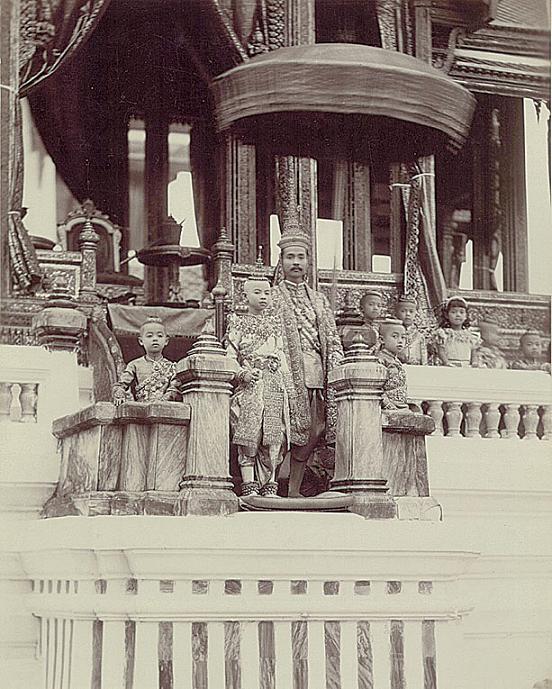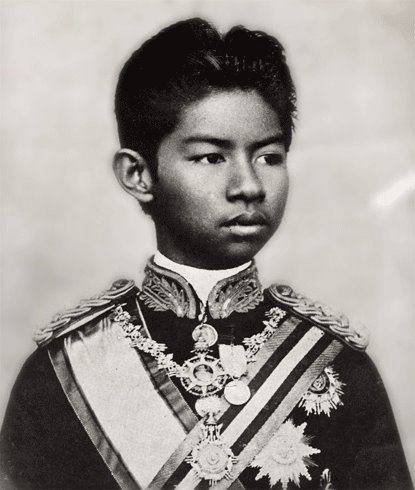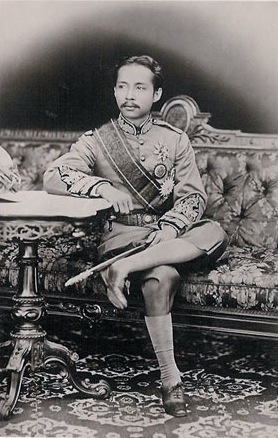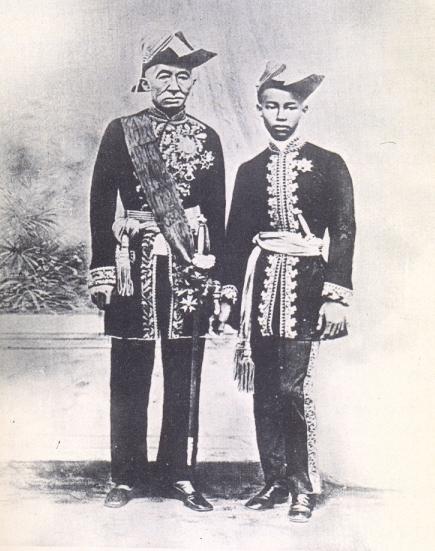|
Vajirunhis
Maha Vajirunhis, Crown Prince of Siam ( th, มหาวชิรุณหิศ; ; 27 June 1878 – 4 January 1895) was the first Crown Prince of Thailand, Crown Prince of the Chakri dynasty. He was the first son of King Chulalongkorn and Queen Savang Vadhana together, who were half-siblings. The King built a palace for the Prince, nicknamed Windsor Palace (Thailand), Windsor Palace. The European-style palace was demolished after his death. The site is now occupied by the National Stadium (Thailand), National Stadium of Thailand. Heir apparent In 1886, after the death of the last Front Palace, Vice King Wichaichan, Bovorn Vichaichan, King Chulalongkorn chose not to appoint one of his brothers as a new Vice King, but instead appointed his eldest son as the Crown Prince of Thailand, Crown Prince of Siam. On 14 January 1886, he was officially introduced to his position with the title of ''Sayam Makutrajakuman'', or Crown Prince of Siam. From this appointment Sir Ernest Mason Sat ... [...More Info...] [...Related Items...] OR: [Wikipedia] [Google] [Baidu] |
Crown Princes Of Thailand
The Crown Prince of Thailand (or Siam; th, สยามมกุฎราชกุมาร; ; lit. the royal son of Siam) is a title held by the heir apparent to the Monarchy of Thailand, Thai throne. First created by King Chulalongkorn (Rama V) in 1886, for his son Prince Vajirunhis, Maha Vajirunhis, the king's eldest son by a royal wife Queen Savang Vadhana. Prior to this, the Siamese throne did not have a law or formal system regulating the royal succession. In 1688 King Petracha of Ayutthaya Kingdom, Ayutthaya created the title of Front Palace, which by the Rattanakosin Kingdom, Rattanakosin period had become the main title granted to the heir presumptive to the throne. However few Front Palaces have succeeded to the throne this way, with the exception of King Buddha Loetla Nabhalai (Rama II) in 1809. After the death of Wichaichan, Bovorn Wichaichan in 1885, the title of Front Palace was abolished and replaced with the title of Crown Prince, who became heir apparent to the t ... [...More Info...] [...Related Items...] OR: [Wikipedia] [Google] [Baidu] |
Crown Prince Of Siam
The Crown Prince of Thailand (or Siam; th, สยามมกุฎราชกุมาร; ; lit. the royal son of Siam) is a title held by the heir apparent to the Thai throne. First created by King Chulalongkorn (Rama V) in 1886, for his son Prince Maha Vajirunhis, the king's eldest son by a royal wife Queen Savang Vadhana. Prior to this, the Siamese throne did not have a law or formal system regulating the royal succession. In 1688 King Petracha of Ayutthaya created the title of Front Palace, which by the Rattanakosin period had become the main title granted to the heir presumptive to the throne. However few Front Palaces have succeeded to the throne this way, with the exception of King Buddha Loetla Nabhalai (Rama II) in 1809. After the death of Bovorn Wichaichan in 1885, the title of Front Palace was abolished and replaced with the title of Crown Prince, who became heir apparent to the throne. In 1924 King Vajiravudh (Rama VI) promulgated the 1924 Palace Law of Suc ... [...More Info...] [...Related Items...] OR: [Wikipedia] [Google] [Baidu] |
Crown Prince Of Thailand
The Crown Prince of Thailand (or Siam; th, สยามมกุฎราชกุมาร; ; lit. the royal son of Siam) is a title held by the heir apparent to the Thai throne. First created by King Chulalongkorn (Rama V) in 1886, for his son Prince Maha Vajirunhis, the king's eldest son by a royal wife Queen Savang Vadhana. Prior to this, the Siamese throne did not have a law or formal system regulating the royal succession. In 1688 King Petracha of Ayutthaya created the title of Front Palace, which by the Rattanakosin period had become the main title granted to the heir presumptive to the throne. However few Front Palaces have succeeded to the throne this way, with the exception of King Buddha Loetla Nabhalai (Rama II) in 1809. After the death of Bovorn Wichaichan in 1885, the title of Front Palace was abolished and replaced with the title of Crown Prince, who became heir apparent to the throne. In 1924 King Vajiravudh (Rama VI) promulgated the 1924 Palace Law of Succes ... [...More Info...] [...Related Items...] OR: [Wikipedia] [Google] [Baidu] |
Savang Vadhana
Sri Savarindira ( th, ศรีสวรินทิรา; , 10 September 1862 – 17 December 1955), also known as Savang Vadhana ( th, สว่างวัฒนา; ), was a consort and half-sister of Chulalongkorn (Rama V), but she was not the ''Rajini'' or the highest ranked consort. After her first grandson's accession to power in 1935, she became known as Somdetch Phra Phan Vassa Ayika Chao (สมเด็จพระพันวัสสาอัยยิกาเจ้า; ; "the Queen Grandmother").Finestone, Jeffrey. ''The Royal Family of Thailand: The Descendants of King Chulalongkorn''. Bangkok : Phitsanulok Publishing, 1989, p. 64 All her children died before her, so she lived to see her grandsons Ananda Mahidol and Bhumibol Adulyadej take the throne. Life She was the 27th daughter of King Rama IV ( King Mongkut or Rama IV) and Princess Consort Piam and thus her husband's half-sister. Her marriage to Chulalongkorn produced the following children: * Crown Prin ... [...More Info...] [...Related Items...] OR: [Wikipedia] [Google] [Baidu] |
Chakri Dynasty
The Chakri dynasty ( th, ราชวงศ์ จักรี, , , ) is the current reigning dynasty of the Kingdom of Thailand, the head of the house is the king, who is head of state. The family has ruled Thailand since the founding of the Rattanakosin Era and the city of Bangkok in 1782; following the end of Taksin Thonburi's reign, when the capital of Siam shifted to Bangkok. The royal house was founded by Rama I, an Ayutthaya military leader of Sino- Mon descent. Prior to his accession to the throne, Rama I held for years the title Chakri, the civil chancellor. In founding the dynasty, the king himself chose "''Chakri''" as the name for it. The emblem of the house is composed of the discus (Chakra) and the trident (Trisula), the celestial weapons of gods Vishnu and Shiva, of whom the Thai sovereign is seen as an incarnation. The current head of the house is Maha Vajiralongkorn who was proclaimed king on 1 December 2016, but has reigned with retroactive effect since 13 ... [...More Info...] [...Related Items...] OR: [Wikipedia] [Google] [Baidu] |
Wichaichan
Krom Phra Ratchawang Bowon Wichaichan ( th, กรมพระราชวังบวรวิไชยชาญ) or Phra Ong Chao Yodyingyot (or Yingyot) (พระองค์เจ้ายอดยิ่งยศ) (6 April 1838 – 28 August 1885) was a Siamese Prince and member of the Chakri Dynasty. He was the eldest son of Viceroy Pinklao and Princess Aim, and thus nephew to King Mongkut (Rama IV). Wichaichan succeeded his father by being appointed the Front Palace and ''Viceroy of Siam'' in 1868, during the reign of his cousin King Chulalongkorn (Rama V).Kesboonchoo Mead P.38 During his tenure the office of Front Palace was extremely powerful and rivalled that of the monarch's own. Inevitably the two forces clashed in the Front Palace crisis. Wichaichan was defeated and the power of the Front Palace was greatly diminished. After his death in 1885, the last vestiges of the title were abolished in favour of a Crown Prince.Kesboonchoo Mead P.95 Early life Phra Ong Chao ... [...More Info...] [...Related Items...] OR: [Wikipedia] [Google] [Baidu] |
Grand Palace
The Grand Palace ( th, พระบรมมหาราชวัง, Royal Institute of Thailand. (2011). ''How to read and how to write.'' (20th Edition). Bangkok: Royal Institute of Thailand. .) is a complex of buildings at the heart of Bangkok, Thailand. The palace has been the official residence of the Kings of Siam (and later Thailand) since 1782. The king, his court, and his royal government were based on the grounds of the palace until 1925. King Bhumibol Adulyadej (Rama IX), resided at the Chitralada Royal Villa and his successor King Vajiralongkorn (Rama X) at the Amphorn Sathan Residential Hall, both in the Dusit Palace, but the Grand Palace is still used for official events. Several royal ceremonies and state functions are held within the walls of the palace every year. The palace is one of the most popular tourist attractions in Thailand. Construction of the palace began on 6 May 1782, at the order of King Phutthayotfa Chulalok (Rama I), the founder of the Chakr ... [...More Info...] [...Related Items...] OR: [Wikipedia] [Google] [Baidu] |
Windsor Palace (Thailand)
Windsor Palace was situated in Bangkok, Thailand, during the early twentieth century. Built on the orders of King Chulalongkorn (Rama V) to serve as the residence of Crown Prince Vajirunhis, the palace later became part of Chulalongkorn University but was later demolished to make way for the construction of Suphachalasai Stadium. The palace became known as such to foreign residents of Bangkok due to its partial resemblance to Windsor Castle, though it was also known to locals as Wang Klang Thung or Wang Mai. History Windsor Palace was commissioned by King Chulalongkorn in 1881 to serve as the residence of his eldest son, Prince Vajirunhis, who would later be named the first Crown Prince of Siam (Thailand). The palace was located on Sa Pathum Road (now Rama I Road) at the current location of Suphachalasai Stadium. Designed in Gothic Revival style by the Italian architect Joachim Grassi, its appearance reflects that of Windsor Castle in England, and the palace became known to cont ... [...More Info...] [...Related Items...] OR: [Wikipedia] [Google] [Baidu] |
Front Palace
Krom Phra Ratchawang Bowon Sathan Mongkhon , colloquially known as the Front Palace ( th, วังหน้า, ), was the title of the ''uparaja'' of Siam, variously translated as "viceroy", "vice king" or "Lord/Prince of the Front Palace", as the titleholder resided in the physical residence of the same name. The office of Front Palace was considered second only to the king and regarded as the heir presumptive. The name, with its dual meaning, originated in the Ayutthaya period, and the holder later gained significant powers during the Rattanakosin period. Front Palace occupants were usually a son or brother of the reigning monarch. The office existed until the death of the last occupant, Prince Vichaichan, in 1885. King Chulalongkorn then abolished the office of an heir presumptive, introducing in its stead the Western concept of a crown prince as heir apparent, and styled the new office " Crown Prince of Siam". Ayutthaya period The ''Uparaja'' or ''Uparat'' concept of a Vic ... [...More Info...] [...Related Items...] OR: [Wikipedia] [Google] [Baidu] |
Vajiravudh
Vajiravudh ( th, วชิราวุธ, , 1 January 188126 November 1925) was the sixth monarch of Siam under the Chakri dynasty as Rama VI. He ruled from 23 October 1910 until his death in 1925. King Vajiravudh is best known for his efforts to create and promote Siamese nationalism. His reign was characterized by Siam's movement further towards democracy and minimal participation in World War I. He had keen interests in Siamese history, archaeology, and literature, as well as economics, politics and world affairs, and founded the country's first university, Chulalongkorn University. Education Vajiravudh was born on 1 January 1881 to Chulalongkorn and one of his four queens and half sister Saovabha Phongsri. In 1888, upon coming of age, Vajiravudh received the title ''Krom Khun'' Thep Dvaravati (Prince of Ayutthaya). Prince Vajiravudh was first educated in the royal palace in Thai and English. His full siblings were Bahurada Manimaya, Tribejrutama Dhamrong, Chakrabongse B ... [...More Info...] [...Related Items...] OR: [Wikipedia] [Google] [Baidu] |
Chulalongkorn At Grand Palace
Chulalongkorn ( th, จุฬาลงกรณ์, 20 September 1853 – 23 October 1910) was the fifth monarch of Siam under the House of Chakri The Chakri dynasty ( th, ราชวงศ์ จักรี, , , ) is the current reigning dynasty of the Kingdom of Thailand, the head of the house is the king, who is head of state. The family has ruled Thailand since the founding of the ..., titled Rama V. He was known to the Siamese of his time as ''Phra Phuttha Chao Luang'' (พระพุทธเจ้าหลวง, the Royal Buddha). Chulalongkorn's reign was characterised by the modernisation of Siam, governmental and social reforms, and territorial concessions to the British Empire, British and French Indochina, French. As Siam was surrounded by Western imperialism in Asia, European colonies, Chulalongkorn, through his policies and acts, ensured the independence of Siam. All his reforms were dedicated to ensuring Siam's independence given the increasing encroac ... [...More Info...] [...Related Items...] OR: [Wikipedia] [Google] [Baidu] |
Chulalongkorn
Chulalongkorn ( th, จุฬาลงกรณ์, 20 September 1853 – 23 October 1910) was the fifth monarch of Siam under the House of Chakri, titled Rama V. He was known to the Siamese of his time as ''Phra Phuttha Chao Luang'' (พระพุทธเจ้าหลวง, the Royal Buddha). Chulalongkorn's reign was characterised by the modernisation of Siam, governmental and social reforms, and territorial concessions to the British and French. As Siam was surrounded by European colonies, Chulalongkorn, through his policies and acts, ensured the independence of Siam. All his reforms were dedicated to ensuring Siam's independence given the increasing encroachment of Western powers, so that Chulalongkorn earned the epithet ''Phra Piya Maharat'' (พระปิยมหาราช, the Great Beloved King). Early life King Chulalongkorn was born on 20 September 1853 to King Mongkut and Queen Debsirindra and given the name Chulalongkorn. In 1861, he was designated ' ... [...More Info...] [...Related Items...] OR: [Wikipedia] [Google] [Baidu] |



.jpg)



.jpg)



